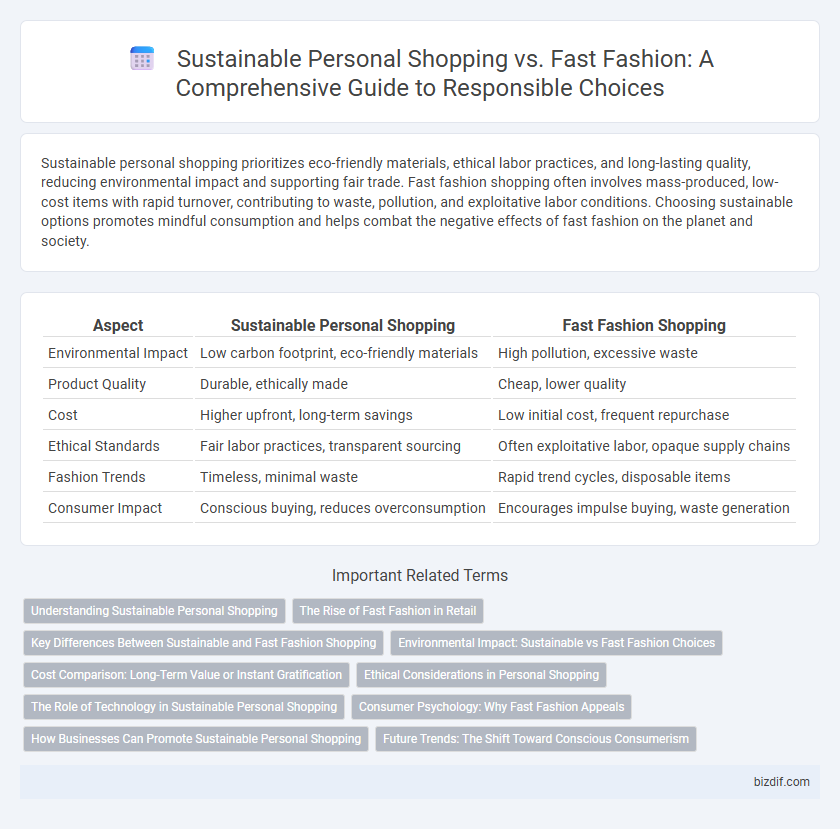Sustainable personal shopping prioritizes eco-friendly materials, ethical labor practices, and long-lasting quality, reducing environmental impact and supporting fair trade. Fast fashion shopping often involves mass-produced, low-cost items with rapid turnover, contributing to waste, pollution, and exploitative labor conditions. Choosing sustainable options promotes mindful consumption and helps combat the negative effects of fast fashion on the planet and society.
Table of Comparison
| Aspect | Sustainable Personal Shopping | Fast Fashion Shopping |
|---|---|---|
| Environmental Impact | Low carbon footprint, eco-friendly materials | High pollution, excessive waste |
| Product Quality | Durable, ethically made | Cheap, lower quality |
| Cost | Higher upfront, long-term savings | Low initial cost, frequent repurchase |
| Ethical Standards | Fair labor practices, transparent sourcing | Often exploitative labor, opaque supply chains |
| Fashion Trends | Timeless, minimal waste | Rapid trend cycles, disposable items |
| Consumer Impact | Conscious buying, reduces overconsumption | Encourages impulse buying, waste generation |
Understanding Sustainable Personal Shopping
Sustainable personal shopping emphasizes choosing eco-friendly, ethically produced clothing that reduces environmental impact and supports fair labor practices. It involves selecting high-quality, durable items designed for long-term use rather than disposable fast fashion, which contributes significantly to textile waste and pollution. Understanding sustainable personal shopping promotes conscious consumer behavior, encouraging investment in timeless pieces and brands committed to transparency and sustainability standards.
The Rise of Fast Fashion in Retail
The rise of fast fashion in retail has dramatically increased the consumption of low-cost, trendy clothing produced rapidly to meet consumer demand. This model often relies on inexpensive materials and labor, contributing to significant environmental degradation and waste. Sustainable personal shopping counters this trend by prioritizing quality, ethical sourcing, and longevity, reducing the ecological footprint associated with fast fashion.
Key Differences Between Sustainable and Fast Fashion Shopping
Sustainable personal shopping emphasizes ethically sourced materials, eco-friendly production processes, and long-lasting quality, reducing environmental impact and promoting fair labor practices. Fast fashion shopping prioritizes rapid turnover of low-cost, trendy items often produced in exploitative conditions, resulting in high waste and resource depletion. The key differences lie in sustainability commitment, product durability, and social responsibility associated with each shopping approach.
Environmental Impact: Sustainable vs Fast Fashion Choices
Sustainable personal shopping significantly reduces environmental impact by prioritizing eco-friendly materials, ethical production methods, and decreased waste. Fast fashion shopping contributes to pollution, waste accumulation, and the depletion of natural resources through mass production and short garment life cycles. Choosing sustainable brands supports lower carbon footprints and promotes long-lasting, responsible consumption patterns.
Cost Comparison: Long-Term Value or Instant Gratification
Sustainable personal shopping often involves higher upfront costs but offers long-term value through durability and reduced environmental impact, contrasting with fast fashion's low prices that prioritize instant gratification but contribute to rapid clothing disposal and repeated purchases. Investing in sustainable brands minimizes waste and supports ethical production, ultimately saving money by reducing the frequency of replacements. Fast fashion's appeal lies in immediate affordability, but the cumulative cost over time can exceed that of quality sustainable pieces.
Ethical Considerations in Personal Shopping
Sustainable personal shopping emphasizes ethical considerations by prioritizing eco-friendly materials, fair labor practices, and reducing waste throughout the supply chain. Shoppers who choose sustainable brands support transparency, ensuring that workers receive fair wages and work in safe environments. In contrast, fast fashion often exploits cheap labor and generates significant environmental harm, raising serious ethical concerns about worker rights and ecological impact.
The Role of Technology in Sustainable Personal Shopping
Technology enhances sustainable personal shopping by providing tools like AI-driven apps that analyze product origins, materials, and ethical practices, helping consumers make informed eco-friendly choices. Online platforms and blockchain offer transparency in supply chains, ensuring authenticity and reducing the environmental impact of fast fashion purchases. Virtual fitting rooms and customized recommendations minimize waste by promoting quality over quantity in personal wardrobes.
Consumer Psychology: Why Fast Fashion Appeals
Fast fashion appeals to consumer psychology by triggering instant gratification through low prices and frequently updated trends, creating a sense of urgency and novelty. Shoppers are often driven by social proof and fear of missing out (FOMO), leading to impulsive purchases despite sustainability concerns. In contrast, sustainable personal shopping emphasizes mindful decision-making, quality over quantity, and long-term value, challenging the fast fashion mindset by promoting eco-conscious consumer habits.
How Businesses Can Promote Sustainable Personal Shopping
Businesses can promote sustainable personal shopping by prioritizing ethically sourced materials and transparent supply chains, reducing environmental impact across production stages. Implementing buy-back programs and encouraging garment recycling fosters circular fashion, minimizing waste and resource consumption. Educating consumers through clear labeling and sustainability certifications enhances informed purchasing decisions that support long-term ecological balance.
Future Trends: The Shift Toward Conscious Consumerism
Sustainable personal shopping embraces ethical production, eco-friendly materials, and durability, reducing environmental impact compared to fast fashion's quick turnover and waste. Future trends highlight increased demand for transparency, circular fashion models, and technology-driven solutions like AI for personalized, eco-conscious choices. Conscious consumerism drives brand accountability and consumer awareness, shifting the industry toward sustainability and long-term value.
Sustainable personal shopping vs Fast fashion shopping Infographic

 bizdif.com
bizdif.com